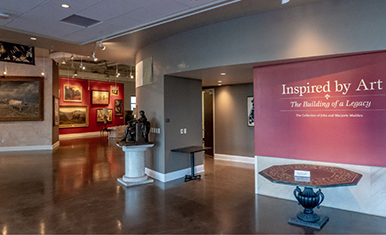Blurring the Boundaries Between Art, Technology and Social Commentary

Playing around with Atari’s “Pac-Man” and “Donkey Kong” video games as a child, Rafael Fajardo had no idea he would one day help transform the video-game world into a socially conscious medium that captured his passion for art and the struggles of the immigrant experience.
Recently chosen as the first Latinx Visiting Artist in residency at Anderson Ranch Arts Center in Aspen/Snowmass to help launch its new Latinx Community Arts Program, Fajardo, an associate professor of Emergent Digital Practices, immigrated from Colombia to the United States with his parents in 1968.
He grew up in San Antonio, earned a BA in studio art and a BFA with a specialization in graphic design from the University of Texas at Austin and, in 1993, received an MFA in graphic design from the Rhode Island School of Design.
While teaching at the University of Texas at El Paso, Fajardo pursued his interest in video games by experimenting with “Cocoa,” an early educational application then under development by Apple.
“It was really, really cute and powerful, fully featured and allowed access to the World Wide Web,” Fajardo said.
When the creators of “Cocoa” redeveloped and released the more powerful “Stage Cast Creator,” Fajardo and a group of like-minded colleagues began crafting games that incorporated social commentary.
Depicting Two Worlds at the U.S.-Mexican Border
“Half the team lived in Ciudad Juárez and half the team lived in El Paso and we critiqued through video games the life we were witnessing,” Fajardo said. “We were self-consciously poking fun at the policy that allowed U.S. corporations to set up ostensibly twin operations on either side of the border. The U.S. side was normally robotic and the Mexican side typically used low-cost human labor.”
Fajardo and collaborators made a game called “Crosser” that reflected that experience and its impact on Mexican workers.
“We put the game player in the position of trying to help a cute brown person across the Mexican border, the Rio Grande and Interstate 10,” he said.
Crosser broke new ground by vividly featuring people previously unseen in video games.
“We demonstrated that a group of Latino, Latina, Chicano, Chicana folks could use technology to open an international dialogue across design history, game history and art history,” Fajardo said.
Expanding the Artistic Capabilities of Video Games
Fajardo began teaching at DU in 2002, where he collaborated with undergraduate students using Stagecast Creator to design video games set in Colombia, providing commentary on the war on drugs. The multidisciplinary approach and attention he and collaborators continue to pay to aesthetic appeal combined with critical sensibility elevate these games from the commercial to the artistic.
“We have managed to have them shown alongside paintings and sculptures in museums and galleries around the world and are using video games as a medium for critical expression capable of doing what other artistic media have done over the course of history,” Fajardo said.
He points out that a novel and a film, for example, “can be both funny and entertaining and also carry rich social commentary that is critical of the cultures in which they were created. We postulated from the beginning that video games could do this, too.”
Fajardo is currently focused on how to historically preserve these video games beyond a 20-year lifespan.
“How can we make choices now using programming language or a working method that lets games exist into the future?” Fajardo said.
To that end, he’s collaborating with DU’s Chris GauthierDickey, associate professor and chair of computer science, and Teaching Professor Jeff Edgington, both from the Ritchie School of Engineering and Computer Science.
Sharing His Vision as Visiting Artist at Anderson Ranch Arts Center
During his residency Sept. 18-Oct. 15 at Anderson Ranch Arts Center Fajardo is diving deeper into how to make his video games endure. He’s already busy creating a new series of games in progress called “The Story of Juan and the Beanstalk,” based on the fictional Colombian coffee representative once featured in advertising campaigns.
“The central narrative conceit is that in the year 2000 a submarine was found in the Andes 8,000 feet above sea level, two full mountain ranges away from the ocean and reported by the BBC,” Fajardo explained. “It made me think how interesting and weird reality in Colombia can be, and how Juan Valdez was the only affirming media character I had access to growing up.
Fajardo will spend one day teaching and conducting workshops for Roaring Fork Valley teachers, participate in a panel discussion and make himself available to teachers and students who might wish to visit on two specified days.
As core faculty at DU’s Latinx Center from its founding and part of the Center for Immigration Policy and Research, Fajardo says he’s honored to be included in Anderson Ranch’s efforts to represent Latinx people.
“This activity resonates with the values of the Latinx Center and because Anderson Ranch is internationally renowned and has sponsored the creation of curriculum about our work, will have broad and lasting reverberations,” he said.




